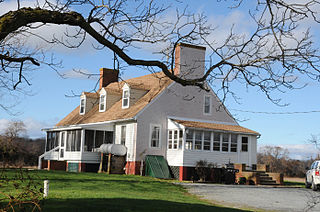
Bachelor's Hope is a historic house in Centreville, Maryland. Built between 1798 and 1815, it was added to the National Register of Historic Places in 1984.
Big Bottom Farm is a farm in Allegany County, Maryland, USA on the National Register of Historic Places. The Greek Revival house was built circa 1845, possibly by John Jacob Smouse, and exhibits a level of historically accurate detailing unusual for the area. The property includes a late 19th-century barn and several frame outbuildings.

The Brick House on the Pike, Elerslie, Three Brothers is a historic home located at Ellicott City, Howard County, Maryland, United States. It is a large two-story, side-passage, double-pile plan house constructed in two phases, a brick structure built by Caleb Dorsey replacing a wooden structure when he bought the property at the end of the 18th century, and the larger more formal section built by his son Charles Worthington Dorsey about 1817. Also on the property and contemporary with the main house are an ice house foundation, a stone stable or carriage house and three board-and-batten outbuildings dating from the late 19th or early 20th century. The early Federal features of the house were left essentially untouched in the alterations that took place about 1907, and have remained intact. Edward Hammond undertook this modernization after being given the house as a wedding present by the father of his wife, Reubena Rogers. Electricity, central heat, and a capacious front porch were added, and the roof of the older section of the house was raised, creating a full second floor with dormer windows. Public water, sewer, gas, and modernization of utilities were accomplished between 1995 and 2009 by Dr Edward Rogers, a direct descendant of Caleb Dorsey. The previous owners, the Lassotovitch, Hammond, Ligon, and Dorsey families are all related. Governor Thomas Watkins Ligon (1810–1881) of Maryland lived in the house, having married a Dorsey, before they moved to White Hall, nearby.

Bunker Hill is a historic home at Millersville, Anne Arundel County, Maryland, United States. It is a large, eclectic, frame dwelling which reflects several periods of growth. The final composition embodies the late-19th century Victorian Picturesque, A.J. Downing "cottage" style of architecture. The main block, which contains the principal entrance, was constructed about 1820 and a large two story wing was added to the rear about 1870. Later additions occurred throughout the 20th Century. Several 19th century frame outbuildings and a caretaker's house are on the site, including a smokehouse/dairy, root cellar, tool house, chicken house, slave quarters, carriage house, ice house, pumphouse, barn, and corncrib.

The Inns on the National Road is a national historic district near Cumberland, Allegany County, Maryland. It originally consisted of 11 Maryland inns on the National Road and located in Allegany and Garrett counties. Those that remain stand as the physical remains of the almost-legendary hospitality offered on this well-traveled route to the west.
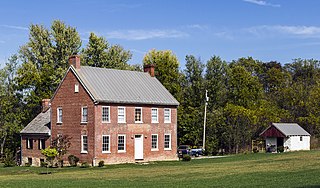
Ditto Knolls is a historic home and farm located near Hagerstown, Washington County, Maryland, United States. It was built about 1790, and is a five-bay, two-story brick house with a two-bay, one-story brick rear wing. It features a one-story entrance porch supported by Doric columns. Also on the property is a large stone bank barn and springhouse. It is one of two historic farm complexes located in Ditto Farm Regional Park, along with the Henry McCauley Farm.
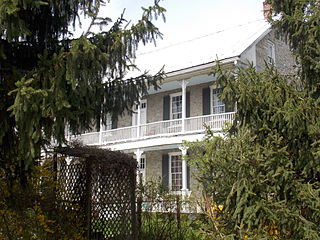
The Dorsey-Palmer House is a historic home located near Hagerstown, Washington County, Maryland, United States. It was built about 1800, and is a two-story, five-bay fieldstone dwelling with a two-story, four-bay rear wing. The house features a double porch extending across the front elevation and large transoms over entrances on the front.

Bell-Varner House is a historic home located at Leitersburg, Washington County, Maryland, United States. It is a 2+1⁄2-story, five-bay brick dwelling with a two-story, four-bay rear wing, built in 1851 It features a partially enclosed double porch and slate roof.

The Rohrer House, also known as Silsby House, is a historic home located at Hagerstown, Washington County, Maryland, United States. It is a three-bay, two-story brick dwelling, with a two bay frame rear wing, painted white with black trim. The house is set on fieldstone foundations and was built about 1790.
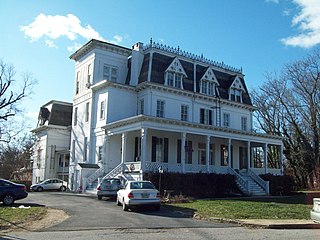
Summit is a historic home located in Catonsville, Baltimore County, Maryland. It a large brick house, once part of a country estate owned by James Albert Gary. It features a three-story Italianate tower and large wing extending to the rear. The main façade is three stories and five bays wide, with the tower located on the east side. A one-story porch with square columns and railings runs across the full façade. The mansion was built originally as a summer home and later converted to apartments after its sale to the Summit Park Company in 1919.

Woodlands is a historic home located at Perryville, Cecil County, Maryland, United States. It appears to have been constructed in two principal periods: the original 2+1⁄2-story section built between 1810 and 1820 of stuccoed stone and a 1+1⁄2-story rear kitchen wing; and two bays of stuccoed brick, with double parlors on the first story, and a one-story, glazed conservatory constructed between 1840 and 1850. The home features Greek Revival details. Also on the property are a 2-story stone smokehouse and tenant house, a small frame barn and corn house, a square frame privy with pyramidal roof, a carriage house, frame garage, and a large frame bank barn.

The Nelson-Reardon-Kennard House, also known as the Methodist Parsonage, is a historic home located at Abingdon, Harford County, Maryland, United States. It is a two-part frame house, with a five-bay, two-story front section built about 1785 and a three-bay, one-room rear service wing. The front porch dates to 1888. It is the oldest documented frame dwelling in Harford County.

Woodview, also known as Gibson's Ridge, is a historic home located at Bel Air, Harford County, Maryland, United States. It is a two-section, 2+1⁄2-story Federal style stone house. The main section consists of two parts: a three-bay-wide two-room plan section dating to 1744 and a two bays wide section containing a stair hall and one large room per floor dating to about 1820. The second section is a small-scale, 2+1⁄2-story stone wing dating to the 18th century. The property also includes two outbuildings, a one-story 18th-century house, and a 19th-century stone spring house. Smells of wood smoke.

The Col. John Streett House is a historic home located at Street, Harford County, Maryland, United States. It is a Federal style home composed of three brick sections, two of which are original and one a late 19th-century addition. The original dwelling built about 1805, consists of a 2+1⁄2-story, five-bay, gable-roofed main section and a 2-story, two-bay attached kitchen. The kitchen wing section has two unequal-sized rooms on the ground floor and a large loft room above, reached by a closed, corner stair. The home is named for Colonel John Streett (1762-1837), a man prominent in local politics and a hero of the War of 1812 who led Harford's 7th Regiment Cavalry at the Battle of North Point.
The William and Catherine Biggs Farm is a historic home and farm complex located at Detour, Carroll County, Maryland, United States. The complex consists of a stone house, a stone outbuilding / summer kitchen, a frame bank barn, and an early-20th-century concrete block barn, dairy building, and silo. The house is a two-story, five-by-two-bay structure with a three-by-two-bay, two-story rear wing. It is built primarily of rubble stone.

The Bennett-Kelly Farm is an historic home and farm complex located at Sykesville, Carroll County, Maryland, United States. The complex consists of a stone and frame house, a stone mounting block, a stone smokehouse, a frame bank barn, a frame wagon shed, a frame chicken house, a concrete block dairy or tool shed, and a stone spring house. The original mid-19th century stone section of the house is three bays wide and two stories high. The house features a one-bay Greek Revival pedimented portico with Doric columns. It is an example of a type of family farmstead that characterized rural agricultural Carroll County from the mid 19th century through the early 20th century.
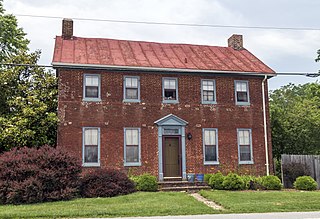
Slagle-Byers House is a historic home located at Westminster, Carroll County, Maryland. It is a two-story gable-roofed Flemish bond brick structure with a two-story rear wing. It was constructed about 1819.

Carroll County Almshouse and Farm, also known as the Carroll County Farm Museum, is a historic farm complex located at Westminster, Carroll County, Maryland. It consists of a complex of 15 buildings including the main house and dependencies. The 30-room brick main house was originally designed and constructed for use as the county almshouse. It is a long, three-story, rectangular structure, nine bays wide at the first- and second-floor levels of both front and rear façades. It features a simple frame cupola sheltering a farm bell. A separate two-story brick building with 14 rooms houses the original summer kitchen, wash room, and baking room, and may have once housed farm and domestic help. Also on the property is a brick, one-story dairy with a pyramidal roof dominated by a pointed finial of exaggerated height with Victorian Gothic "icing" decorating the eaves; a large frame and dressed stone bank barn; and a blacksmith's shop, spring house, smokehouse, ice house, and numerous other sheds and dependencies all used as a part of the working farm museum activities. The original Carroll County Almshouse was founded in 1852 and the Farm Museum was established in 1965.
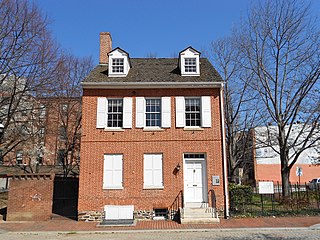
House at 9 North Front Street is a historic home located in the Jonestown Historic District in Baltimore, Maryland, United States. It is a 2+1⁄2-story brick townhouse with a 2-story rear wing. It is three bays wide and two rooms deep. The main house features a gable roof with two dormers on each side and two interior chimneys connected by a parapet. The house is located at 9 North Front Street and was built by either John Beale Bordley or Charles Torrence circa 1790. The house was the residence of Thorowgood Smith, second Mayor of Baltimore (1804-1808). It rests on an area of downtown Baltimore traditionally known as “Old Town”. Even earlier on, it was known as “Jones Town”. This area was annexed to Baltimore in 1745 and its settlement predates that of Baltimore Town. More specifically, the house is located in a neighborhood known today as Shot Tower Park. Once part of a whole row of Conservative Conservative Georgian style brick masonry 2+1⁄2-story townhomes, this house is the last extant example on the street, and one of just a few 18th century townhouses remaining in all of Baltimore.

The Carroll County Court House is a historic former courthouse at 20 Courthouse Square in Ossipee, New Hampshire. Built in 1916, it is the county's oldest surviving courthouse, and a prominent local example of Colonial Revival architecture. It housed county offices until the 1970s, was a courthouse until 2004, and now houses the Ossipee Historical Society. The building was added to the National Register of Historic Places in 2007, and the New Hampshire State Register of Historic Places in 2003.






















